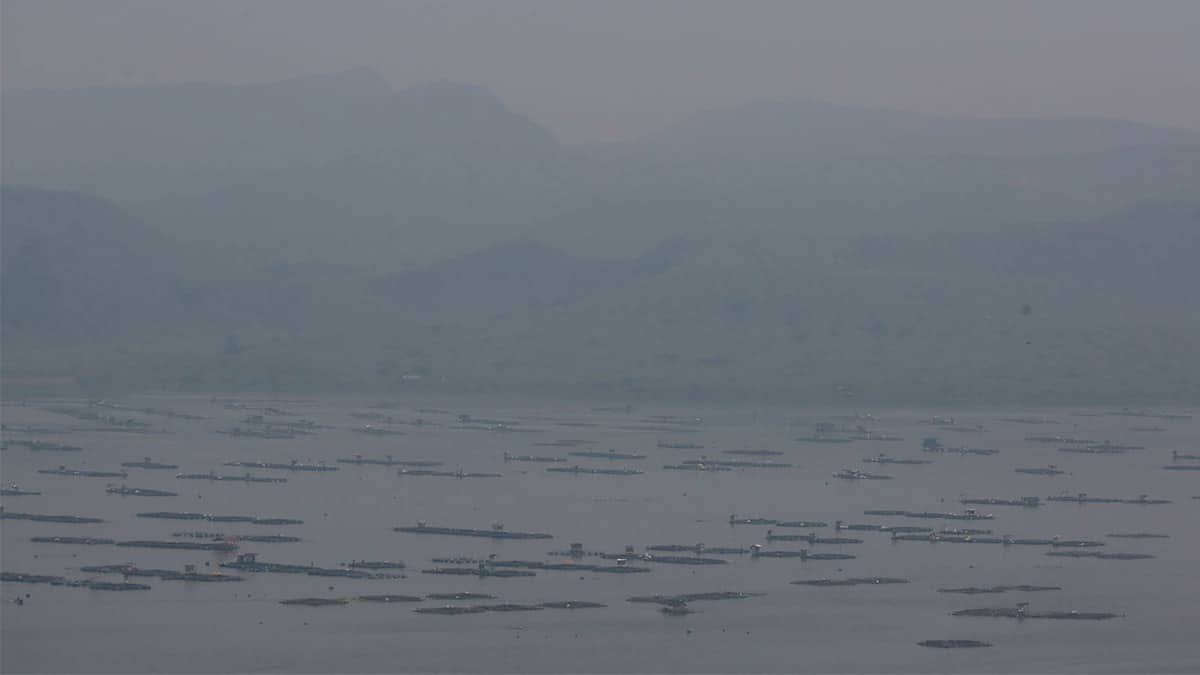
POOR VISIBILITY Thick volcanic smog or vog covers Taal Volcano Island and Taal Lake in Batangas province on Monday. Classes were suspended in parts of Calabarzon region on Monday due to health risks from the vog. —Richard A. Reyes
MANILA, Philippines — Volcanic smog, or “vog” spewing from Taal Volcano forced the suspension of classes in Calabarzon (Cavite, Laguna, Batangas, Rizal, Quezon) region on Monday, as health authorities called on affected residents to wear face masks outdoors.
Parts of Metro Manila were also blanketed by haze, leading to school closures in some cities, but experts clarified that the smog, or the combination of smoke and fog, in the capital region, was likely caused by local pollutants and not by volcanic emissions.
Education Secretary Juan Edgardo Angara issued Department of Education (DepEd) Memorandum No. 46, authorizing affected schools to suspend classes in the absence of an official announcement from the local government units.
READ: Smog is not vog
The memo cited recent phreatic or steam-driven eruptions of Taal Volcano and its release of vog over the past 24 hours, which the Philippine Institute of Volcanology and Seismology (Phivolcs) classified as a “voluminous emission.”
In an advisory also issued on Monday, the Department of Health (DOH) urged the public to avoid exposure to harmful vog and smog by limiting outdoor activities and keeping doors and windows closed in houses or establishments, and staying hydrated by drinking water.
Acidic droplets
The DOH also asked residents to cover their noses and mouths or wear N95 face masks, if available, when outside.
Vog contains acidic droplets of volcanic gas like sulfur dioxide, which can irritate the eyes, throat and respiratory tract.
Health authorities warned that people with asthma, lung or heart disease, the elderly, pregnant women and children were especially vulnerable.
On Monday, Phivolcs reported the emission of 3,355 metric tons of sulfur dioxide rising some 2,400 meters above Taal Volcano Island, locally known as “Pulo,” which sits within Taal Lake, before drifting in the north to northwest direction.
State volcanologists observed an “upwelling of hot volcanic fluids” in the main crater lake of the volcano.
The presence of vog was also noted during the Aug. 17-18 monitoring period.
In early August, Phivolcs detected a number of phreatic eruptions varying in length and intensity. A phreatic eruption is a “steam-driven explosion that occurs when water beneath the ground or on the surface is heated by magma, lava, hot rocks, or new volcanic deposits (for example, tephra and pyroclastic-flow deposits),” Phivolcs said.
Not magmatic
Taal remains under alert level 1, or “low-level unrest,” which means a “slight increase” in its activity.
But the unrest is unlikely to progress into a magmatic eruption based on the background levels of volcanic earthquake activity and the detected ground deformation, Phivolcs said.
Before the release of the DepEd order, several schools in Cavite, Laguna and Batangas provinces had already suspended classes. Some local governments ordered a total suspension, while others shifted to online or modular classes.
Among the cities and towns that suspended classes were Balete, Ibaan, Laurel, Lemery, Lipa, Malvar, Nasugbu, San Jose, San Luis, Santo Tomas, and Tanauan, all in Batangas; Alfonso, Dasmariñas, Indang, and Silang in Cavite; Biñan and Calamba in Laguna; and Lubang in Occidental Mindoro.
The cities of Las Piñas, Muntinlupa, and Pasay in Metro Manila also suspended classes on all levels.
But the Department of Environment and Natural Resources’ Environmental Management Bureau clarified that the smog in Metro Manila was due to typical pollution in the metropolis.